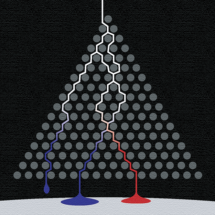
Cell-to-cell variability in gene expression level (noise) has emerged as one of the fundamental concepts in genetics. Non-genetic, cell-to-cell variation in the abundance of a gene product can generate a diversity of behaviour in genetically identical population of cells. This phenomenon is pervasive and prevalent in development (e.g. stem cells) and disease (e.g. cancer). Genome-scale studies on gene expression noise have revealed that some genes are more random in their expression than others. In the case of important regulatory proteins that determine cell fate or survival, random variation in their abundance can result in very different behaviours of individual cells that make up a population despite being genetically identical. Work carried out by Madan Babu’s group in the LMB’s Structural Studies Division has used structural, biophysical and genomic information to propose a theoretical framework that provides insights into the molecular basis of the emergence of gene expression noise. Specifically, they describe how variability in the assembly of the transcription initiation complex at a promoter can lead to variability in expression level of a gene.
The work, led by Charles Ravarani in Madan’s group, looked at how the general transcription factor TATA-box binding protein (TBP), the sequence of its binding site, the complexes it can form, and their respective residence times at a promoter can make a gene more or less noisy. By integrating large-scale datasets that describe genomic binding patterns of proteins, biophysical measurements of protein-DNA interaction, their dynamics, and structural information on TBP and their interaction factors, they proposed a mechanistic model that can explain the emergence of noise. Using computer simulations, they explored the key parameters, and verified aspects of the model through experiments in yeast. The findings suggest that the interplay between affinity and competition for an essential regulatory factor (TBP) can influence the kind of protein complex that can be assembled (i.e. promoting or inhibiting transcription) at a promoter among different individuals of a cell population. This may lead to heterogeneities in the assembly of gene expression machineries, resulting in expression variability among cells, even though they carry the same genetic information. The principles may represent a more general framework that is applicable to every major step along the process of gene expression and not just transcription initiation as investigated in this work.
An understanding of the molecular aspects that influence noise represents a first step in developing strategies to modulate and engineer the extent of random variation in a cell population. For instance, by modulating the concentrations of the key regulatory molecules, one could affect noise of a subset of genes or globally regulate noise to push the cell population to either have consistent or variable level of gene expression. This strategy of homogenization of the phenotypic diversity of cells could be exploited in synthetic biology applications, and to counter the massive variability in gene expression levels seen in various diseases. It could also be exploited to aid reprogramming of stem cells.
The work was funded by the MRC, an AFR scholarship from the Luxembourg National Research Fund, a Gates Cambridge Scholarship, a Knox Trinity studentship, and a Simons Foundation Junior Fellow award.